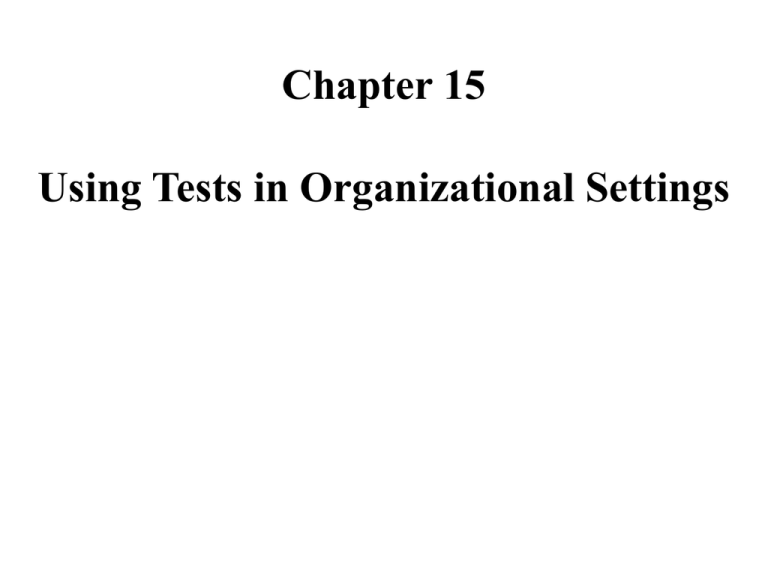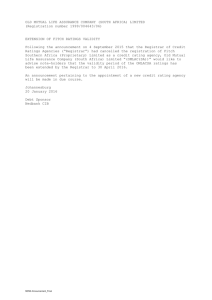Document
advertisement

Chapter 15 Using Tests in Organizational Settings History • Walter Dill Scott (1915) “The Scientific Selection of Salesmen” – proposed that employers use group tests for personnel selection. • Scott’s influence led to Army Alpha & Beta testing during WW I. Those were discontinued following WWI. • Employment testing, however, continued when Millicent Pond (1927) studied the selection and placement of apprentice metal workers. • Strong-Campbell Interest Inventory originated from this early work. • The Psychological Corporation organized by J. McKeen Cattell began. History (continued) • WW II: Army General Classification Test (AGCT) developed by Bingham (chief psychologist of War Dept.). • Multiple commercial applications have since been developed. • 1964 Civil Rights Act stimulated interest in insuring that tests were valid and fair. • 1978 – Uniform Guidelines for Employee Selection were developed. Pre-employment Testing The Employment Interview Traditional – “getting to know you function.” …Biased by sex, age, race, and physical attractiveness. -This bias has been attributed more to the interviewer than to the process. Pre-employment Testing (cont.) The Employment Interview Structured – standardized, allows scoring. Higher inter-rater reliability, internal consistency, and concurrent validity. – Focus on behavior – what you have done or can do rather than how you feel about… – Each candidate receives the same questions in the same order. – The questions require a job analysis covering important job functions and duties (content validity); therefore job related. – E.g, Human Resources Professional Job Interview Performance Tests • High-fidelity tests replicate the job setting as realistically as possible; e.g., flight simulator. – Assessment Centers – large scale replications of the job that require candidates to solve typical job problems by role playing or demonstrating proficiency. • Low-fidelity tests simulate the job task using a written, verbal, or visual description. – Video tests – candidates are shown typical job situations and asked to choose his/her response from multiple choice format. • Validity of performance tests in predicting job performance =.54 • Have high content validity, and are job related. Tests for Specific Types of Jobs E.g., Personality Inventories • Examine traits found useful in predicting job success: conscientiousness, extraversion, emotional stability, etc. E.g., The 16PF Questionnaire (developed by Raymond Cattell) gives a profile. • Poor predictors of job success generally. Five-factor Model of Personality (NEO Personality Inventory) 1. 2. 3. 4. 5. NEUROTICISM EXTRAVERSION OPENNESS TO EXPERIENCE AGREEABLENESS CONSCIENTIOUSNESS The Hogan Personality Inventory (HPI) • Adjustment • Ambition • Sociability • Likeability • Prudence • Intellectance • School success (Validity key to detect careless or random responding.) The Hogan Personality Inventory Predictive Validity: • Sociability predicts sales revenue (r=.51) • Prudence predicts supervisors’ ratings of conscientiousness (r=.22) • School Success predicts training performance (r=.34-.55) Integrity Testing Two categories: – Physiological measures – Paper-and-pencil tests • Physiological – polygraph tests - problem with false positives (mistakenly classifying innocent takers as guilty) and poor predictive validity. • The Employee Polygraph Protection Act lf 1988 forbids the use of the polygraph as an employment test. Interestingly, employers providing security services and government agencies are exempt from this law! • Paper-and-pencil integrity tests predict counterproductive behaviors (.29-.39). • But highly susceptible to faking. Legal Constraints • 1978 Uniform Guidelines for Employee Selection catalog “best practices” to promote fairness and legal defensibility of employment practices. (Note: Congress did not pass the Guidelines and therefore they are not federal law.) • Any process that is used to make a hiring decision is defined as a “test.” Includes application forms, reference checks, letters of reference and tests. • All employment tests must be job-related and based on a job analysis. • “Adverse impact” is the exclusion of a disproportionate number of persons belonging to a protected class based on race, gender, age, etc. In these cases, alternative methods for assessing job candidates must be found. Performance Impairment Tests • An alternative to chemical analysis for the presence of drugs. • Can use a simulation to detect impairment in motor skills or hand-eye coordination (similar to a video game). • Compare to the individual’s baseline. • Can be done quickly and easily in the workplace as opposed to taking the employee off the work site for drug testing. Performance Appraisal • Ranking employees (best to worst) – Forced distribution to get a normal curve, using categories such as “outstanding,” “above average,” etc. – prevents the ranker from assigning all people to one category. • Rating employees – graphic rating scale- each of the scales represents a dimension, such as quality or quantity of work. Guided by anchors. – Behaviorally anchored rating scales (BARS) use onthe-job behaviors as anchors for the rating scale. – Behavioral checklist - rating frequency of important behaviors. Performance Appraisal • Rating Errors – Leniency errors – giving all employees better ratings than they deserve. – Severity errors – giving all employees worse ratings than they deserve. – Central-tendency errors – using only the middle of the rating scale and ignoring highest and lowest scale categories. – Halo effect – when raters let their judgment on one dimension influence judgments on other dimensions (ie.,giving low rating on quality and quantity of work when employee met standards for quantity of work) • 3600 feedback: ratings from supervisors, peers, subordinates, or customers.




